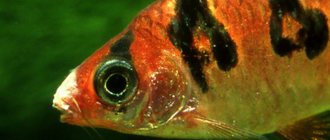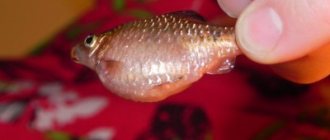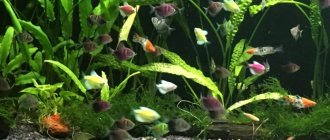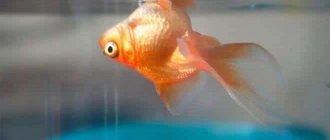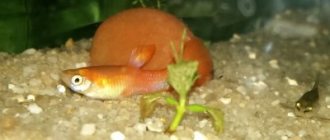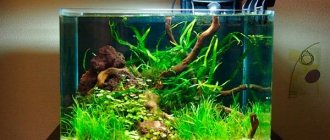“Flights” of fish over the surface of the water are not such a rare sight. And if an artificial reservoir is not equipped with a lid or mesh, then sometimes the owner finds his pets near the reservoir and it’s good if he manages to return them “home”.
What is the reason for this behavior? There is no need to look for it if the fish belongs to a species for which jumping ability is a natural property. They can jump quite high above the surface. And if the tank is small in size or filled with water almost flush with the edges, sometimes they miss and fall next to the walls. There are many such “jumpers” among popular aquarium fish. These include black macropods, zebrafish, barbs, Siamese cockerels, tetra-congos, flag platies, red neons, swordtails, etc. Therefore, when purchasing representatives of one or another species, you should definitely inquire about their tendency to escape and equip the aquarium accordingly.
It’s another matter if fish, for which such behavior is not typical, try to leave the home pond. This may indicate a problem in the ecosystem. Let's look at the most common reasons for deviations from the norm.
Lack of space
Each individual requires its own living space. And not only in order to stay there calmly, the fish need a place to swim and maneuver freely. If the aquarium is overcrowded or too small and low, the pets experience a lack of exercise. Without calculating the speed or trajectory, they can jump over the side. This is especially true for large and schooling fast-swimming fish. Therefore, when purchasing a tank and populating it, it is important to strictly follow the requirements of how many liters of water are needed for each individual of a particular species. And it’s better to leave a reserve, because the fish can outgrow the original size of the vessel.
Desire to migrate
Clari catfish (Clariidae), labyrinthine fish (Anabantidae) and snakehead fish (Channidae) have a rare feature - they can breathe the same air as humans. In nature, they need this in order to leave a drying up body of water and go in search of another body of water nearby. All you can do to prevent the fish from realizing their suddenly awakened instinct is to get a heavy lid that they cannot move with their powerful body.
Poor aquarium shape
The most comfortable “house” for the inhabitants to live in is a cube or parallelepiped. But here, too, some nuances must be taken into account, in addition to shape and volume. So, for the same fast-swimming schools, you need a tank with a wall length of at least 80 cm, otherwise they will constantly hit the wall with their foreheads in the literal sense. Or jump out. Bizarrely shaped aquariums are very impressive from an interior point of view, but are not suitable for living. For example, in ball vessels, rounded walls amplify sounds from the outside many times over and direct them to the center of the container. Because of this, the inhabitants constantly experience stress, and with a sharp sound they can jump out of the water in fear.
Why do fish jump out of the aquarium - Reason. Dangerous proximity of incompatible fish
Predatory and territorial fish, even with enough space and food, chase their calm small neighbors, and often injure them. Some species of fish also become aggressive during the period of spawning and protection of eggs.
But clashes that lead to jumping out of the aquarium also happen between completely peaceful fish. Sometimes this happens due to a lack of food, but more often it happens when the container is clearly overcrowded. Too many neighbors irritate absolutely all the fish, and they begin to show aggression towards each other.
Incorrectly adjusted or faulty equipment
Here the following factors must be taken into account:
- Lighting.
Too bright or, on the contrary, dim light, or lighting not turned off at night can cause anxiety in fish. It is necessary to select the power of the lamps in accordance with the volume of the tank and the needs of its inhabitants. For fish that are active at night, dim lamps are needed, as well as equipment for darkened shelters. - Filtration.
If the filter does not cope with its function, organic waste begins to rot, poisoning the aquatic environment. The fish instinctively try to leave it. Working too hard on the filter results in strong currents, which can cause stress. Look for a middle ground. - Aeration.
Both a lack and an excess of oxygen can be a source of concern. Neither the filter nor the aerator can be turned off for a long time - at night or while the owners are away. - Heater.
The water temperature must correspond to the conditions for keeping this type of fish. Overheating is especially dangerous - the fish will try to escape from the aquarium to avoid being cooked. This often happens if they try to combine cold-blooded and warm-blooded species. - Violation of the integrity of the insulation
of electrical wires located in water. This leads to current leakage into the water. The inhabitants receive electric shocks and naturally strive to leave the dangerous place.
Other diseases
In addition to breeding and fin problems and typical ailments, there are many other illnesses that can occur in guppies. If you identify atypical behavior or appearance of your pet, you should carefully examine the fish and analyze all the signs, thereby determining the type of disease. It should be remembered that the earlier the disease is detected, the greater the chance of curing the guppies. However, the best option will, of course, be to avoid illnesses - proper care, balanced nutrition and proper living conditions.
Dropsy
Dropsy, or ascites, most often occurs due to overfeeding fish, poor water quality, or viral pathogens. Symptoms of ascites appear as follows:
- the fish hides or spends time at the bottom;
- the abdomen is swollen;
- eyes become swollen;
- the scales rise and look ruffled.
Fish suffering from dropsy can be cured by disinfecting the aquarium and fasting. Additionally, salt is added to the liquid - 1 tbsp. spoon for 10 l.
Read also: Why do the brushes on an angle grinder burn?
Trichodinosis
Trichodinosis is the reason why guppies float on the surface of the water. The disease is dangerous because in the early stages the disease is difficult to detect, and often aquarists only realize it when they discover that the guppy has died. In order not to torment yourself with the question of why the fish in the aquarium are dying, you need to carefully monitor them. Symptoms of the disease are the following external signs:
- gray-blue coating on the gills and body;
- fish rub against the decorations;
- guppies try to get to the surface of the water;
- They stay in one place for a long time, as if suspended.
Treatment is carried out by increasing the water temperature to 34C and increasing the power of the aerator. Additionally, methyl blue is dissolved in the liquid, observing the proportions indicated on the package.
Columnaria
Columnaria in guppies occurs due to bacteria, poor care, incorrect water parameters, new infected neighbors and stress. It appears as a light coating on the body, the fins lose their beauty and integrity, look shabby, and at an advanced stage the fins are completely pressed against the body. With complications, plaque spots transform into ulcers and can also take on a thread-like form. You can cure fish by carrying out frequent fluid changes and using the drugs chloramphenicol - 250 g per 10 l, and kanamycin - 1 g per 25 l of water.
Ichthyophthiriasis
Ichthyophthiriasis, or semolina, looks like light dots or blotches on the body of the phenotype, which over time transform into sores or scratches. Ichthyophthiriasis is a contagious disease, so an individual that has died from this disease should be destroyed immediately so as not to risk the health of other fish.
When decoying aquarium fish, treatment is carried out using salt - 1 teaspoon per liter of liquid. The saline solution is introduced into the aquarium gradually, or the infected fish are dipped into the bath for 10 minutes. You can also use the drugs Biomycin and Tripaflavin, using 50 thousand units. of the first medicine and 5 mg of the second. The course of treatment is 2 weeks, but you should not stop the course until all the specks and light spots disappear from the pets’ bodies.
Many guppy diseases are curable if the symptoms of the disease are detected in time, therefore, when keeping and breeding fish, it is necessary to carefully take care of your pets, following the rules of care and nutrition. It should be remembered that the best way to cure a disease is to prevent it.
Improper aquarium care
- Cleaning.
Fish are frightened by sudden movements and accidental touches of hands, as well as the soil cleaner, and the sounds of friction when using a scraper. So all manipulations must be as careful as possible. - Water change.
Inexperienced aquarists sometimes perform a complete water change unless absolutely necessary. Finding yourself in a completely new environment is extremely stressful for the inhabitants, forcing them to randomly rush around the aquarium. They may even die.
Reasons for fish jumping out in natural bodies of water
- Fear. Fish are shy, especially Asian carp. At loud sounds, he jumps out of the water in fear. Fishermen often use this; they hit the water sharply with their oars, and the fish sometimes jumps out and falls straight into the boat.
- Chasing predators. Often small fish jump out of the water because larger predators are chasing them. These types of fish even have fins that act as wings.
- Procurement of food. There are species of fish that jump out to grab small flying insects, which they catch to feed their small offspring.
- Laying eggs. There are also small species of fish that lay eggs on the leaves of coastal plants. They jump out of the water to accomplish this mission.
- Overcoming obstacles. Salmon fish that live in the waters of the Pacific Ocean, during their migration, move vast distances along rivers; on their way they encounter obstacles in the form of rapids, to overcome which the fish make their jumps.
Diseases and poisoning
- Excited behavior may be caused by parasites burrowing into the gills. Infected fish rush around the aquarium, itching on stones and decorative objects. Sometimes the sensations are so unbearable that pets jump out of the water.
- The same reaction can be caused by hydrogen sulfide poisoning, the source of which is excrement, rotting food residues, and dead parts of the plant. In this case, it is necessary to clean the water with a siphon and perform a water change.
- Abnormal jumping may be one of the initial manifestations of any disease. If, under normal environmental conditions, the fish tends to leave it, you need to consult a veterinarian.
- Poisoning is caused by toxic substances accidentally entering the water. Most often this happens when spraying chemicals near an uncovered aquarium - when spraying indoor plants or baiting insects. This can also happen if the walls of the vessel are washed using the wrong detergent.
Preparing for fishing in superstitions
The connection between luck on the river and natural features is explained by physical and biological properties. Many superstitions regarding preparation for fishing cannot be interpreted in a logical way. Why you shouldn’t rush when getting ready - it’s understandable; those in a hurry always forget something. No one will say why long, scrupulous preparations are prohibited. Moreover, it is not clear why the sex life of fishermen affects fishing. At the same time, avid lovers of sitting with a fishing rod refuse intimate life on the eve of a trip to a pond.
Other superstitions are associated with the ban on swearing, quarrels with others, and empty promises. It is believed that those who promise to catch a lot will return with nothing. There is a known ban on mentioning scales. If the wife shows displeasure that she will have to clean the catch again and fight the scales, she scares away luck from her husband. Experienced people never shave the day before going to a pond.
Important! The ban on food taken from home, in the preparation of which fish and seafood were used, is strictly observed. Although no one can justify it.
They leave early in the morning while the house is asleep. This way there is a greater chance of leaving without wishing you good luck, which will ruin the matter. On the way they avoid meeting women, priests, and police officers. And the main thing is that for the bite to be successful, they go to the pond in a good mood, with a light heart. Irritability and a gloomy mood are known as obstacles to good luck.
If important fishing equipment is forgotten, they return, but before leaving, they stick their tongue out at the reflection in the mirror. This is an ancient way to regain the favor of higher powers and scare away evil spirits. Shoes for the same purpose are first put on the left foot.
Prevention and first aid
To prevent escape, you need to:
- cover the container with a breathable lid, or even better, with a net, so that the fish does not get injured when jumping;
- the surface of the water should be 8-10 cm below the edges of the tank;
- place floating plants on the water surface - they will detain the escapees and contribute to the creation of an optimal biobalance.
Let's imagine that the fish fell out of the aquarium. She has a chance to survive. It all depends on the height of the fall, the time spent on land and the consequences of the impact. If less than a minute has passed, the pet must be rinsed in water scooped from the aquarium and examined. If there is no visible damage, you can return it to its place. But monitor her for a few days for possible infection or hidden injury. If an injury is evident, the specimen must be placed in a quarantine aquarium filled with water from a community aquarium. Add a few drops of healing conditioner to the container.
If more than a minute has passed but less than an hour, try to revive the fish in a heavily aerated tank. This usually takes several days.
Following the rules for populating an aquarium and caring for it will help avoid escapes and their unpleasant consequences.
Injuries
Injuries can be caused by altercations between males and fights between fish of different species. Therefore, it is important that there are a sufficient number of females in the aquarium. The optimal ratio is three girls for one boy. In addition, fish can be injured by sharp edges of equipment, decorations, and soil.
In order to avoid infection and the appearance of white plaque on the surface of the wound, hydrogen peroxide (5-10 ml per 20 l) or iodinol is injected into the water. You can also use streptocide.
Why do they do this?
Some fish are naturally jumpy, some use this trick to escape . But besides these, there are other explanations for this behavior of aquarium inhabitants, and they are not always harmless.
Let's look at each of the reasons in more detail, and also give advice on solving the problem.
Lack of space
Fish cannot live on each other's heads . Each requires a certain amount of space to live.
If your aquarium looks like a teeming anthill, and the fish are almost colliding head-on with each other, then you cannot avoid situations when some of them end up on the floor outside of it.
Fin rot
This bacterial infection is common in swordtails. It affects fry and adults with weakened immune systems. External signs of the disease include clouding and destruction of the fin. The disease is curable only if the damage has not spread to the fish’s body, otherwise the rot will primarily affect the nervous system.
If you notice the first signs of the disease in time, the treatment will be successful. It is enough to place all sick swordtails in a separate container and use a weak solution of methylene blue instead of water. The liquid should have a pale turquoise color.
Treatment with salt has a good effect. Dissolve 1 tablespoon in 10 liters of water. This will not harm healthy swordtails, and the number of cases will decrease.
If these measures do not help, then it is worth using chloramphenicol. 1 crushed tablet per 20 liters of water is enough.
After signs of the disease have disappeared, swordtails must be quarantined for at least another 5 days.
Ichthyophthiriasis (semolina)
The cause of the disease, as a rule, is improper living conditions, especially sudden changes or low temperature. The swordtail itches on stones, soil and all protruding objects. A rash resembling semolina appears on the body. If the fish begins to lower its fins, this is also one of the symptoms of the disease.
The cause of the disease is ciliates equiciliata. It is often found in aquariums, but only individuals with low immunity become ill. There is no effective treatment for this disease. The only way to improve the situation is to gradually raise the water temperature to +26 and protect the swordtails from stress. The fish's body must cope with the disease on its own.
Dropsy
As a rule, dropsy occurs as a result of exposure to a viral or bacterial infection, poor nutrition, the presence of parasites, temperature changes, or high levels of nitrites or nitrates in the water. Swordtails become infected from contact with fellow tribesmen, soil or live food.
External signs of the disease:
- apathy;
- swordtails lie on the bottom;
- breathe quickly;
- swollen abdomen;
- the scales are swollen and stick out in an unnatural way;
- often hang in one place.
To rid your pet of excess liquid, add Epsom salt to the water (1-2 tsp per 40 liters of water). The problem can also be eliminated with the help of the following drugs: potassium permanganate, maracin, chlorafeminicol, bicilin.
Infection often poses a danger to people, so protective gloves are worn when working with fish.
What types of aquarium inhabitants have suicidal tendencies?
Theoretically, any fish can jump out, but there are certain species that do this due to a hereditary predisposition .
Their ancestors caught flying insects, escaped from predators, or migrated from body of water to body of water when unfavorable conditions occurred.
Jumping fish include:
African and American cichlids;- shark barbs;
- macropods;
- zebrafish;
- poecilius;
- tetra-congo;
- cockerels, etc.
It is noteworthy that fish living in the upper and middle layers of the aquarium may be more likely to end up outside of it. When having such fish in an aquarium, be sure to ensure that the lid is always closed.
Chilodenellosis
The cause of this disease is a very small parasitic creature called Chilodonella.
- reduced activity (the sick individual freezes in place and sways slightly);
- the fish's appetite decreases;
- the fin, which is located on the back, descends, and if you look closely, you can identify a gray-blue coating underneath it.
As a rule, swordtails suffer from chylodenosis more often than all other species. Even if different types of fish live in the aquarium, parasites often settle only on swordtails.
Chilodenelosis is eliminated with the help of antiprotozoal drugs. The success of treatment depends on the stage of the disease. The earlier treatment is started, the higher the chances of survival. All sick individuals must be quarantined.
